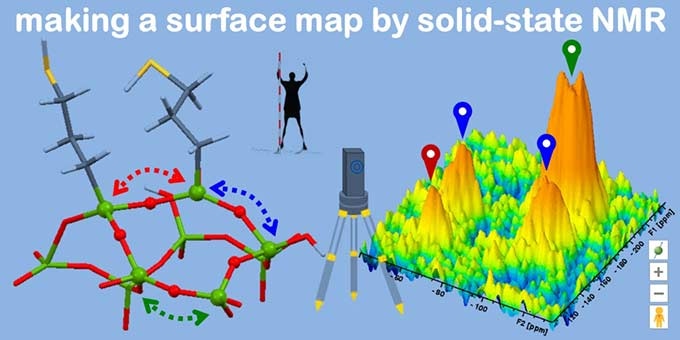Jun 21 2019
At the U.S. Department of Energy’s Ames Laboratory, advanced nuclear magnetic resonance (NMR) methods have exposed unexpected details about the structure of a core group of materials in nanotechnology — mesoporous silica nanoparticles (MSNs) — and the placement of their active chemical sites.
 (Image credit: Ames Laboratory)
(Image credit: Ames Laboratory)
MSNs are honeycombed with minute three-dimensionally ordered tunnels or pores that measure just 2 nm –15 nm in width, and act as supports for organic functional groups modified to a wide range of requirements. With probable applications in catalysis, biosensing, chemical separations, and drug delivery, MSNs are the focal point of intense scientific research.
“Since the development of MSNs, people have been trying to control the way they function,” said Takeshi Kobayashi, an NMR scientist with the Division of Chemical and Biological Sciences at Ames Laboratory. “Research has explored doing this through modifying particle size and shape, pore size, and by deploying various organic functional groups on their surfaces to accomplish the desired chemical tasks. However, understanding of the results of these synthetic efforts can be very challenging.”
Ames Laboratory scientist Marek Pruski clarified that regardless of the existence of different methods for MSNs’ functionalization; nobody knew precisely how they were diverse. Specifically, atomic-scale description of how the organic groups were spread on the surface was lacking until lately.
It is one thing to detect and quantify these functional groups, or even determine their structure. But elucidating their spatial arrangement poses additional challenges. Do they reside on the surfaces or are they partly embedded in the silica walls? Are they uniformly distributed on surfaces? If there are multiple types of functionalities, are they randomly mixed or do they form domains? Conventional NMR, as well as other analytical techniques, have struggled to provide satisfactory answers to these important questions.
Marek Pruski, Scientist, Ames Laboratory
Kobayashi, Pruski, and other scientists used DNP-NMR to get a much vivid picture of the structures of functionalized MSNs. “DNP” means “dynamic nuclear polarization,” a technique which uses microwaves to stimulate unpaired electrons in radicals and shift their high spin polarization to the nuclei in the sample being tested, offering considerably higher sensitivity, frequently by two orders of magnitude, and even greater savings of experimental time.
Conventional NMR, which measures the reactions of the nuclei of atoms positioned in a magnetic field to direct radio-frequency excitation, lacks the sensitivity required to recognize the internuclear interactions between various sites and functionalities on surfaces. When paired with DNP, as well as rapid magic angle spinning (MAS), NMR can be used to sense such interactions with unparalleled sensitivity.
Not only did the DNP-NMR techniques obtain the atomic-scale location and distribution of the functional groups, but also the results invalidated some of the current concepts of how MSNs are created and how the diverse synthetic strategies impacted the distribution of functional groups across the silica pores.
By examining the role of various experimental conditions, our NMR techniques can give scientists the mechanistic insight they need to guide the synthesis of MSNs in a more controlled way.
Takeshi Kobayashi, NMR Scientist, Division of Chemical and Biological Sciences, Ames Laboratory
The research is discussed in detail in “Spatial distribution of silica-bound catalytic organic functional groups can now be revealed by conventional and DNP-enhanced solid-state NMR methods,” authored by T. Kobayashi and M. Pruski; and published in ACS Catalysis.